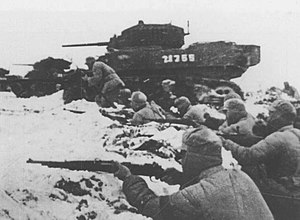Shuangduiji Campaign
| Battle of Shuangduiji | |||||||
|---|---|---|---|---|---|---|---|
| Part of the Chinese Civil War | |||||||
 PLA troops, supported by M5 Stuart light tanks, engage Nationalist lines |
|||||||
|
|||||||
| Belligerents | |||||||
|
National Revolutionary Army |
People's Liberation Army |
||||||
| Commanders and leaders | |||||||
|
|
|
||||||
| Strength | |||||||
| 120,000 | 280,000+ | ||||||
| Casualties and losses | |||||||
| 46,000 killed 50,000 captured 5,500 defected |
36,000 total | ||||||
The Battle of Shuangduiji (双堆集战役) was a major campaign fought between the nationalists and the communists during the Chinese Civil War in the post-World War II era, resulting in a communist victory. The campaign was part of the Huaihai Campaign.
After the Battle of Nianzhuang, in which the nationalist commander Huang Baitao's () 7th Army was completely annihilated, the communists were divided on deciding the next target. After a heated debate, it was finally decided on November 22, 1948, that the next target should be the nationalist 12th Army commanded by Lieutenant General Huang Wei (). A total of 7 columns (the equivalent of a corps) of the communist Central China Field Army (the equivalent of an army group) and 2 columns of the communist Eastern China Field Army would be tasked to annihilate the nationalist 12th Army in the region to the south of Kuai River(), while the main force of the communist Eastern China Field Army would be tasked to prevent any nationalist troops in Xuzhou and Bangbu () from reinforcing the nationalist 12th Army.
The nationalists, on the other hand, had a much more solid objective of reestablishing the line of communication and transportation between Xuzhou and Bangbu by eradicating the communist forces in the region. To achieve this, the nationalists would launch a pincer movement from both south and north, with Lieutenant General Qiu Qingquan's () 2nd Army and General Sun Yuanliang's () 16th Army in the north, and Lieutenant General Li Yannian's () 6th Army and 12th Army in the south, with 12th Army attacking toward Xiu County() from Mengcheng.
Nationalists
Communists
On November 23, 1948, the nationalist 12th Army began its attack on Nanping Village (Nanpingji, 南坪集) on the southern bank of the Kuai River(澮河) by deploying the 10th Corps to the left, the 14th Corps to the right, the 18th Corps in the center and the 85th Corps behind the 18th Corps. The 4th Column of the communist Central China Field Army engaged the advancing nationalists, retreating gradually to lure the nationalists toward the communist trap by eventually abandoning Nanping Village in the evening of November 23, 1948. On the morning of November 24, 1948, the nationalist 12th Army crossed the Kuai River, and entered the trap the communists had set up in the regions of Dongpine Village (Dongpingji, 東坪集), Ren Family's Village (Renjiaji, 任家集), Seven Miles Bridge, (Qiliqiao, 七里橋), Red Mouth (Zhukou, 朱口). Realizing that his forces were trapped, Huang Wei ordered his troops to retreat southward, planning to join another nationalist 6th Army commanded by Lieutenant General Li Yannian () in Hu's Ditch Village (Hugouji, 胡溝集) and Solid Town (Gujeng, 固鎮) by traveling along the southern shore of the Kuai River. Once the two nationalist armies, the 6th and the 12th, had joined together, they would travel northward along the Tianjin-Pukou Railway.
...
Wikipedia
